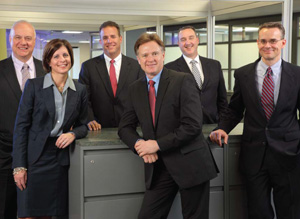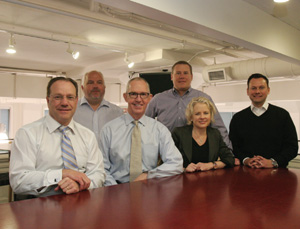
(l–r): David Jahner, Executive Vice President; Stephanie Guin, Executive Vice President–Human Resources; Michael Bowman, Vice President–Kansas City Branch.
FAITH TECHNOLOGIES
Even in a highly specialized service business—like electrical contracting—competition can be fierce in the best of times. Recent years have not been the best of times for many in the construction sector. But at Faith Technologies, the downturn consisted of a single year, 2010, before revenue growth pulled ahead of 2009, and it’s been rising ever since. Tom Clark, executive vice president of preconstruction, said the company had redoubled efforts to monitor costs, but made sure employees bought into that with more effective communication. “We wanted them all to know how they could positively impact the business through their job,” he said. Everyone in the company, then, had input to the One Faith strategic planning initiative, aligning their roles with the organizational vision. “By allowing everyone to hear what our big-picture goals were as an organization, we allowed them to think outside of the tougher economic times,” Clark said. “Overall, it did just come down to attitude and staying positive.”
The Wisconsin-based company also invests in a benefits program that attracts, retains and develops nearly 1,500 employees—208 of them at the regional branch in Lenexa. Atop standard benefits like tuition reimbursement, an employee assistance program and insurance coverages (life, accidental death and dismemberment, short-term and long-term disability) are more updated and sector-specific benefits: identity-theft protection, emergency travel assistance, and reimbursements for safety shoes and safety glasses. The effort to balance benefit costs with employee needs has produced a comprehensive approach to health insurance and wellness that includes semi-annual newsletters and monthly wellness posters, lunch-and-learn sessions, reimbursements for flu shots and health club costs, run/walk event and recreational sports fees, annual health-risk assessments, a nicotine-cessation program, and in the break rooms, free oatmeal, fresh fruit and green tea, plus healthy offerings in vending machines. To top that off, employees hitting wellness goals can earn cash rewards, gift cards, and other prizes.
All of it comes wrapped up in a system of incentives and performance-based compensation, creating “a culture that promotes individual contributions to the organization,” says Stephanie Guin, executive vice president for human resources. “Every employee in the organization has an opportunity to advance his or her career.”

(l–r): William Bradley, Jr., Executive Vice President, Chief Administrative Officer, General Counsel and Secretary; Aimi Daughtery, Chief Accounting Officer; Robert Knapp, Chief Operating Officer; Harry Herington, Chief Executive Officer and Chairman of the Board; Ron Thornburgh, Sr., Vice President of Business Development; Stephen Kovzan, Chief Financial Officer.
NIC, Inc.
Here’s a novel approach that can bolster any company’s efforts to be a great employer: At NIC, Inc., one of the core values is being not just a great place to work, but the best company its employees have ever worked for. To get there, this public company factors in employee involvement, work-life balance, wellness programming, and community and charitable involvement.
NIC builds Web sites, online services and payment-processing systems for more than 3,500 federal, state and local government agencies, and does it well: It was the only Midwestern company to make the Forbes list of “25 Fastest-Growing Technology Companies in America,” ranking 20th in a field that contained names like Apple and LinkedIn. The magazine also has designated NIC as the only Kansas company in its “100 Best Small Companies in America” for four straight years.
Two keys to playing at that level are the compensation structure and a robust benefits package. “If people are happy and healthy, their chance of success on both personal and professional levels is much higher,” says CEO Harry Herington. To get them there, NIC offers a competitive-salary foundation for all employees, and managers receive cash bonuses and performance-based stock compensation. Almost unheard of in this era, NIC still offers 100 percent employer-paid health and dental insurance premiums for employees and their dependents. The insurance suite includes short- and long-term disability, life and accidental death/dismemberment, and term life for spouses and dependents. Addressing the long-term financial welfare of its staff, NIC provides a 401(k) contribution match of up to 5 percent of a participant’s annual salary, as well as a stock-purchase plan with a 15 percent discount.
The company supplements employees’ health-club memberships and mobile-phone expenses, offers a retail discount program, and provides over 50 kinds of complimentary healthy foods and drinks to support its culture of wellness for a staff of 113 employees at the headquarters in Olathe and more than 620 in other offices around the country.

(front row, l–r): Brett Gordon and Pat McCown, Co-CEOs; Nancy Whitworth, Vice President-Human Resources; Ramin Cherafat, Vice President. (back row, l–r): Jay Lucas, Vice President-Field Operations; Jeff Placek, CFO.
McCOWNGORDON CONSTRUCTION
Pat McCown and Brett Gordon stared into the darkest hours of a long downturn in the construction sector, which only recently gave way to light. Then they acted. “In the depths of the economic downturn, we embarked on a strategic planning process that has brought clarity and purpose to our work” at McCownGordon Construction, says Nancy Whitworth, human resources director for the Kansas City contractor. From that foundation came new programs in leadership, mentoring and new-associate orientation, and “instead of cutting the training budget during the challenging years,” Whitworth said, “we doubled it. And those investments are paying off by leaps and bounds.” Set aside for a moment all the talk about competitive pay, great benefits and carnival rides in the break room, and consider this: When the threat to a business is existential, isn’t a great company the one whose leadership finds a way, first and foremost, to keep the doors open?
That’s where a corporate culture begins. You can build on it, as with McCownGordon, through company outings for laser tag or bowling, holiday parties, anniversary cards and birthday gift cards from the executive team, and team-building through community outreach with Habitat for Humanity, Christmas in October or Ronald McDonald House. But providing a job is, well, Job One.
That sense of purpose is at work in the company’s response to health-care costs, launching a range of wellness activities—competitive walks, weight-maintenance challenges, healthy-recipe cook-offs—aimed, as Whitworth said, at delivering “the best possible benefits package for our associates at the best possible value for the money.” The same goes for creation of a two-tiered health plan; associates can choose between a base plan and a more robust plan with higher employee contributions. Or the litany of changes Whitworth notes: an on-site fitness center, free fruit and healthy food, bicycles, wellness lunch-and-learn sessions, health-risk screenings, walking challenges, weight-loss competitions, sponsored walks, and more. “Our surveys show that these efforts inspire associates to live healthier lives,” she said. “Our next goal is to make the program even more results-oriented.”
With 101 employees, McCownGordon is the smallest in this Best Companies to Work For category, but it packs a punch well above payroll weight: Concerted efforts to pay above-market wage rates, a generous company co-pay on health and dental insurance—and full payment for disability and life plans—and a 401(k) with a company contribution equal to 3 percent of an employee’s salary, regardless of their own contribution level.